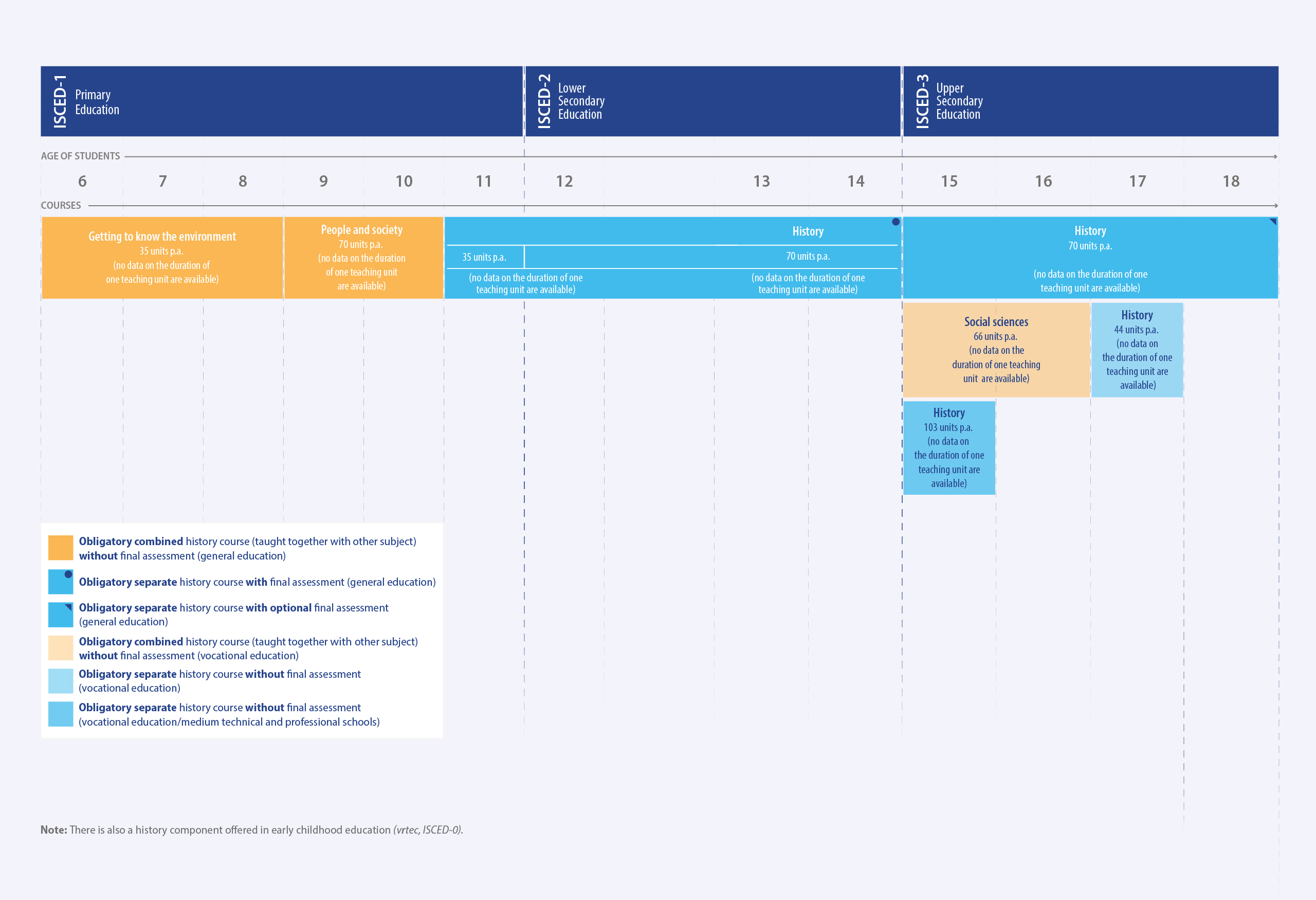
OVERVIEW
In Slovenia, history teaching begins in the first grade through multidisciplinary courses. History becomes a standalone subject in the sixth grade and remains compulsory throughout the public schooling system, with a final assessment required at the end of lower secondary education (age 14). Vocational education offers both multidisciplinary and standalone courses which are compulsory and vary in length depending on the programme followed.
The history curricula follow a chronological, thematic and competence-based organisation. They are developed with the participation of civil society organisations and minority groups, and confirmed by the Expert Council of the Republic of Slovenia for General Education. Schools for the Italian and Hungarian minorities include in their history curricula more content on their respective histories, and some schools for the Hungarian minority teach bilingually. Private schools may follow a distinct history curriculum.
Assessment methods include portfolios, essays, oral presentations/exams, knowledge-based questions and source-based questions. A final exam is taken at the end of lower secondary education and is optional at the upper secondary level. The selection of resources takes place at the school level, and teachers are permitted to use materials not licensed by the authorities without any restrictions. Initial teacher-training programmes are provided by universities, the National Education Institute and teachers’ associations. In-service professional development programmes are optional and limited to five working days a year.
Download high-resolution schematic
FURTHER INSIGHTS

HISTORY IN SCHOOL
History teaching in Slovenia begins in the first grade with the multidisciplinary course “Getting to know the environment” (ages 6-8), followed by the multidisciplinary course “People and society” (ages 9-10). History then becomes a compulsory standalone subject, continuing through to the end of lower secondary education (age 14) and including a final assessment. At upper secondary level, “History” is a compulsory course for all four years (ages 15-18), but the final assessment is optional. Vocational education students take “Social sciences” for two years (ages 15-16) and “History” for one year (age 17); those in medium technical and professional schools take “History” for one year only (age 15).
Schools for the Italian and Hungarian minorities include in their history curricula more content on their respective histories, and some schools for the Hungarian minority teach bilingually. There are private schools in Slovenia which may follow a distinct history curriculum.

HISTORY CURRICULUM
All types of schooling within the state system follow programmes confirmed by the Expert Council of the Republic of Slovenia for General Education. At both the primary and secondary levels, the history curricula have compulsory elements with some optional elements which are chosen by teachers according to students’ interests and their own professional judgment. They also allow for activities that may take place inside and outside the classroom. The history curricula are developed with the participation of both civil society organisations and minority groups.
|
AIMS REPRESENTED “VERY WELL” OR “QUITE WELL” IN THE CURRICULUM |
PERIODS |
GEOGRAPHICAL SCOPE |
APPROACHES |
|
|
|
|
The authorities report that minority groups (cultural, ethnic, linguistic, national, religious or sexual/gender) are included in the history curriculum, however these do not include Roma and Travellers.
Curricula workstation by GEI (History curricula search by country)

ASSESSMENT AND EXAMS
The assessment methods teachers are required to use are portfolios, essays, oral presentations/exams, knowledge-based questions and source-based questions.
End-of-stage examinations are compulsory for the lower secondary course “History” and optional for the upper secondary course “History” (both courses are compulsory). The exams are set at the national level.
End-of-stage exams assess the following fields of knowledge: historical content knowledge, historical thinking competences (e.g., critical analysis and evaluation of evidence, formulation and justification of historical arguments, consideration of different perspectives).
End-of-stage examinations are written and consist of open-ended questions, closeended questions, source-based questions and multiple-choice questions.

TEXTBOOKS AND OTHER RESOURCES
The selection of resources to use for teaching takes place at the school level, and teachers are permitted to use materials not licensed by the authorities without any restrictions.
Policies on the use of different types of educational resources are as follows:
|
|
|
|
International TextbookCat (GEI collection of Textbooks and Educational Media)

HISTORY TEACHERS AND THEIR EDUCATION
Initial teacher-training programmes are provided by universities, the National Education Institute and teachers’ associations.
At both primary and secondary school levels, teachers are trained to teach history and one or more other discipline(s).
In-service professional development programmes are optional. They are administered by experts from the National Education Institute and universities, and are partially financed by the Ministry of Education. Teachers have a maximum of five working days a year to attend training courses.
Slovenian History Teachers’ Association (presentation by EuroClio)
The information in the sections above is an excerpt of the thematic and general data presented in the following OHTE publications:
2022: Pandemics and natural disasters as reflected in history teaching
2023: OHTE General Report on the State of History Teaching in Europe



